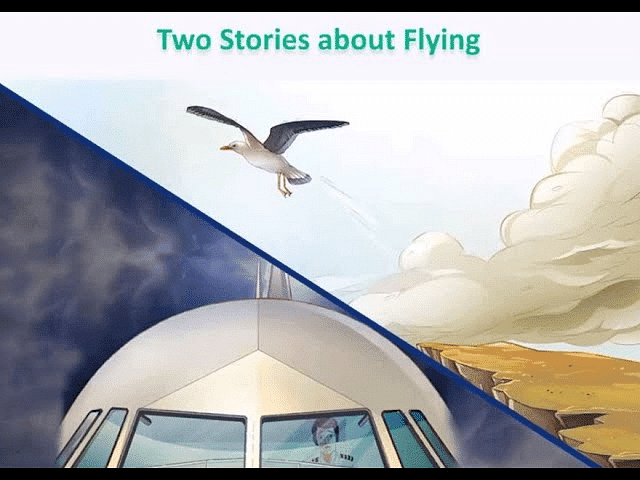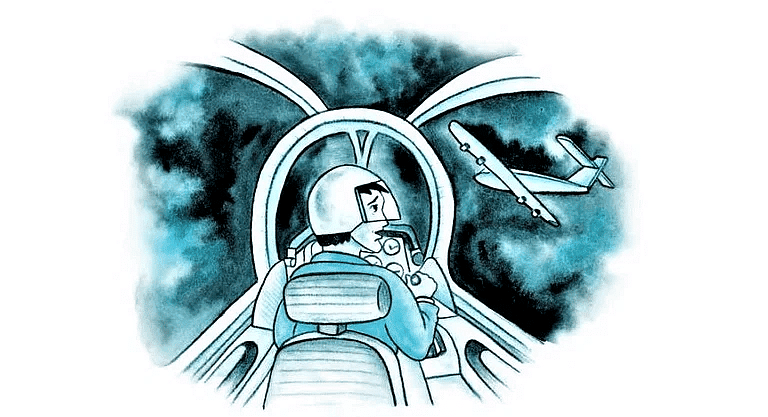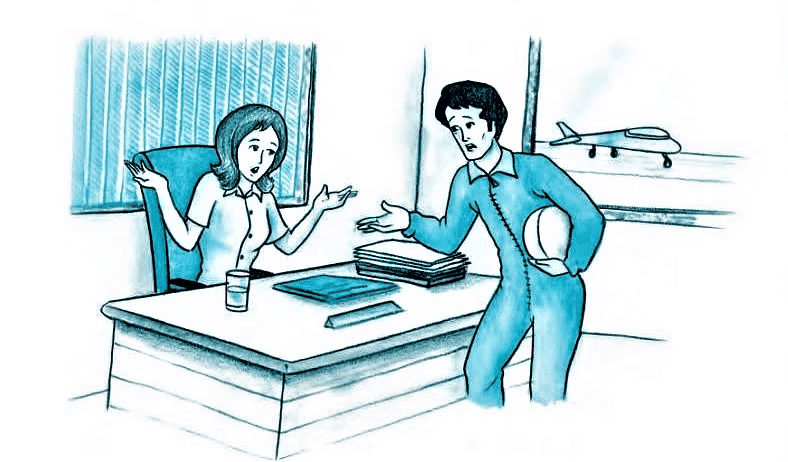Class 10 English Chapter 1 Question Answers - First Flight
Q1: Describe the methods used by the seagull family to help the young seagull overcome his fear and fly.
Ans: This story is about a young seagull. The time had come when he should fly like his parents and brothers and sister. But he was afraid to fly. His parents tried their best to teach him how to fly. But he refused to fly. They left him alone on his ledge. They threatened him that he would starve. Even then he was too afraid to fly. His brothers and sister made fun of him. They laughed at his cowardice. At last, his mother thought of a plan. She took a piece of fish in her beak and flew towards him. She came near him but did not land on the ledge. The young seagull was very hungry. He came to the brink of the ledge. In order to get food, he dived at the fish. But he fell from the rock. He became terrified. But it was only for a moment. The next moment, he flapped his wings and started flying. In this way, his mother was able to make him fly.
Q2: What message does the story ‘His First Flight’ convey?
Ans: This is an imaginary story. The story conveys the message that we learn by taking courage and not by sitting idle. A young seagull is fed lovingly by his parents. But when the time comes for him to fly, he feels afraid. His parents try many tricks to teach him to fly. But he is so afraid that he refuses to fly. At last, his mother hits upon a plan. She tempts him with food in her beak. But she only flies near his ledge and does not land there. In order to get food, the hungry seagull comes to the edge of the rock and falls from it.At first, he is terrified but then he opens his wings and starts flying. He is happy to note that he did not fall in the sea. In this way, the young seagull makes the first flight of his life when he takes courage.
Q3: What happened after the seagull had learnt how to fly?
Ans: The seagull came to the brink of the ledge in order to get the fish from his mother. But his mother remained in the air. a little away from the ledge. The seagull dived at the fish. But he fell from the rock into space. He cried with fear. But this fear lasted only a moment. The next moment, he flapped his wings. He was surprised to find that he was flying. He screamed with joy. He soared higher and higher. His parents flew around him. They praised him for learning how to fly. Then his parents, brothers and sister landed on the sea. They beckoned the young seagull to come to them. The seagull dropped his legs and came down on the surface of the sea. He had thought that the surface of the sea was green flooring. But his legs started sinking into the water. He again screamed with fear. However, his belly touched the water and he did not drown. He started floating on the water. His family members were also happy. They gave him pieces of a fish to eat.

Q4: The mother of young seagull picked up a piece of fish but still did not come nearer to give him. Why did she do so? Did she lack love for her son or she wanted to make him courageous? What values does the mother depict through her act? Write in 100-120 words.
Ans: The young seagull was terribly afraid to fly. His parents encouraged him to make his first flight. But he could not do so. Then, the mother picked up a piece of fish but did not go near to give him. The seagull was extremely hungry. He started crying so that his mother would give him some food. But after coming towards him, the mother stopped opposite to him but almost within his reach. When the seagull dove to get the piece, she swooped upwards. Maddened by hunger, the young seagull spread his wings upwards and started flying. This shows that the mother wanted her son to become courageous. This shows that sometimes parents take such harsh steps for their kids which may appear wrong at that time but later prove to be beneficial for their kids.
Q5: Was the young seagull same at the beginning and at the end of the lesson? Compare and contrast the two kinds of the same seagull in the lesson.
Ans: No, the young seagull was not the same bird at the beginning and at the end of the lesson. In the beginning, the young seagull used to be all alone on his ledge. His two brothers and his sister had flown away the day before. He had been afraid of flying with them. Whenever he tried to flap his wings, he was seized with fear. He felt certain that his wings would never support him. His father and mother flew around calling him shrilly. They were constantly scolding and taunting him. They were threatening to let him starve on his ledge unless he flew away.However, the young seagull was more confident and sure of his success in the end. Maddened by hunger, he dived at the fish. After trials and errors, his wings spread outwards. He was soaring gradually downwards forgetting all his hesitations and fears. He could float on the ocean now. His success was welcomed by his family. They were praising him now and their beaks were offering him their scraps of dog-fish.
Q6: ‘All parental acts are for the betterment of the children.’ It is true. However, one has to make efforts through trials and errors shedding off one’s early hesitations and fears to succeed in any enterprise. Justify this statement by taking points from the lesson ‘His First Flight’.
Ans: There is no doubt about it ‘All parental acts are for the betterment of the children’. It is the ardent wish of every parent that they may teach all skills to their young ones so that they may succeed in life. First of all, they can learn all the things which their parents have taught in life. If the young ones don’t act then they also indulge in scolding, taunts and humiliating them to shed off their hesitations and fears. This is exactly what the parents of the young seagull did. They were successful in teaching the art of flying to his two brothers and sister. They also tried their best to embolden him to take the plunge. Particularly, the mother-seagull went on flying around him with a piece of fish in her beak. It was her attempt to tempt her starving son to dive at the fish. And she succeeded in her aim. The young seagull did dive at the fish and it led to his success in the end.
Q7: Describe the humiliation and taunting that the young seagull faced from his family when he used to sit alone on his ledge without mustering his courage to fly in the air.
Ans: The young seagull used to sit on the ledge all alone. He used to see his two brothers and sister flying around him. They had learnt flying only the day before. Not that he didn’t try before. He had come to the edge of the ledge and tried to flap his wings. But he became afraid soon. He felt certain that his wings would never support him. So, he bent his head and ran away to the little hole under the ledge. His brothers and sister had far shorter wings than his own. But they succeeded flapping their wings and flew away. He failed to muster his courage to take the plunge. His father and mother flew around him scolding and taunting him. They also threatened to let him starve on his ledge unless he flew away. The thing that compounded his agony was that his elder brother had caught his first herring and devoured it. His parents circled around his brother raising a proud cackle. On the other hand, the family had walked down the opposite chiff taunting him with his cowardice.
Q8: Hesitations and fears play necessary parts in human life but we get success in any enterprise only when we overcome our doubts, hesitations and fears. Justify this statement in light of the young seagull’s efforts to muster the courage to fly in the air.
Ans: Nothing in life can be taken for granted. Skills have to be learnt in life with your own efforts. Parents can only help in teaching and encouraging us to learn things. But we have to learn them through our own efforts of trials and errors. Who doesn’t suffer from hesitations and fears in the beginning? It takes time to take the final plunge. So, it happened with the young seagull. In spite of constant encouragements and motivations, he couldn’t muster the courage to fly. He was certain that his wings would not support him. He faced regular taunting and humiliations of his family. They even threatened to let him stare at the ledge unless he flew away. But they say that necessity is the mother of invention. Maddened by hunger, he dived at the fish which his mother was carrying in her beak. He felt his wings spreading outwards. Finally, he soared to come down over the sea. When he floated on the sea, his family celebrated his success by offering pieces of fish to him.

Q9: Describe the flight of the pilot before he encountered dark clouds.
Or
Describe the flight of the Dakota aeroplane until it landed safely at the airport.
Ans: The writer of this story is a pilot. One night he was flying his old Dakota aeroplane over France. It was a starry night. He was going to England. He hoped to spend his holiday with his family. It was an easy journey and he was in a joyful mood. He looked at his watch. It was one-thirty in the morning. Through his wireless, he contacted Paris Control. They told him to turn twelve degrees west. He did as he was advised to do. He was 150 kilometres from Paris. Suddenly the writer saw huge black clouds before him. It was not possible to fly up and over the clouds. He had not much fuel with him. So, it was not possible to fly around the big mountains of clouds to the right or left. He decided to take the risk and flew his aeroplane straight into the clouds.

Q10: The narrator had two options of avoiding the terrible storm clouds. Why didn’t he use them? Was his decision of flying straight into storm clouds a sound decision? Give a reasoned answer.
Ans: The narrator could see black mountains of clouds all around him. They were storm clouds. He had two options and by using them he could avoid the terrible storm clouds. He could go back to Paris. He had left Paris 150 kilometres behind. He wanted to go back but the temptation of having an early breakfast at home stopped him. He couldn’t fly up and above the storm clouds either. He didn’t have enough fuel to fly around them to the north or south. It seems that flying back to Paris would have been the best option in those circumstances. He couldn’t fly north and south of the storm as he hadn’t enough fuel in the second tank. His decision of flying straight into the storm clouds was motivated by his having an early English breakfast with his family. It was rather a bold but risky decision. He would have been in deep trouble, had the pilot of the strange black aeroplane not helped him to safety.
Q11: Describe the appearance of the strange black aeroplane in the most hopeless situation. How did the pilot of the black aeroplane help the narrator to come out of the storm clouds and land safely?
Ans: The narrator was really in deep trouble. The huge mountains of black clouds were around him. The old Dakota aeroplane was jumping and twisting in the air. His compass was dead. The other instruments were dead too. Nothing worked for him. Even his efforts to contact Paris control failed. The radio was dead too. In such a hopeless situation, the sudden appearance of a mysterious black aeroplane was like God’s sent help for him. There were no lights on the wings of that black aeroplane. The narrator could see the pilot’s face. He was saying “Follow me”. The narrator was totally lost. He thought that the pilot was trying to help him. So he followed the black aeroplane like an obedient child. He was frightened as he had fuel enough to last for five or ten minutes. Suddenly, he came out of the clouds. He saw two long straight lines of lights in front of him. It was a runway. He was out of danger and could land safely. He turned to look for his rescuer in the black aeroplane, but the sky was empty.
|
30 videos|419 docs|58 tests
|
FAQs on Class 10 English Chapter 1 Question Answers - First Flight
| 1. What are the main themes explored in the stories about flying? |  |
| 2. How do the characters in the flying stories demonstrate personal growth? |  |
| 3. What role does the setting play in the stories about flying? |  |
| 4. How do the stories about flying inspire young readers? |  |
| 5. What literary devices are commonly used in the flying stories, and how do they enhance the narrative? |  |

|
Explore Courses for Class 10 exam
|

|


















